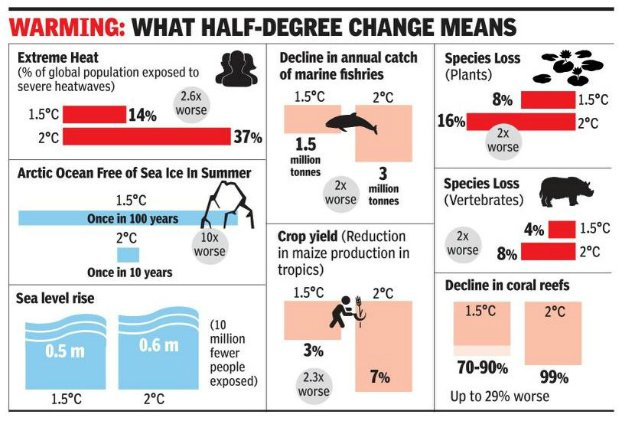United Nations Intergovernmental Panel on Climate Change (IPCC) has released special report on global warming in Incheon, South Korea.
Key Points from report
- It clearly shows how half degree of warming makes big difference, adversely impacting global population and overall ecosystem through intense heat waves, melting of Arctic, sea level rise, erratic rainfall, reduction of farm yield and vanishing of living species.
- It is possible to meet new warming target, provided nations together take rapid and far reaching transitions over next 10 to 20 years in energy, industry, land use, buildings, transport and cities to cut emissions and reach net zero around 2050 — 25 years earlier than planned under earlier 2-degree goal.
- It lists four pathways to curb global warming and through which the 1.5 degree target can be achieved. In each of pathways, global average temperature is projected to overshoot 1.5 degrees Celsius target by some amount before returning to that level before the end of this century.
- Each of these pathways is also dependent on some amount of Carbon Dioxide Removal (CDR), a reference to physical removal of stock of CO2 from atmosphere to reduce its concentrations. Varying amounts between 100 to 1000 gigatons (billion tonnes) of CO2 needs to be removed from atmosphere in these four pathways.
- It refers to climate models that project robust differences in regional climate characteristics between present-day and global warming of 1.5 degrees Celsius and between 1.5 and 2 degrees Celsius.
- These differences include increase in mean temperatures in both land ocean regions, hot extremes in most inhabited regions, heavy precipitation in several regions and probability of drought and precipitation deficits in some regions.
Advantages of keeping global temperature rise within 1.5 degrees Celsius
- It also lists several specific advantages of keeping the global temperature rise within 1.5 degrees Celsius from pre-industrial levels.
- By 2100, global sea level rise would be 10 cm lower with global warming of 1.5 degrees compared with 2 degrees Celsius.
- Arctic Ocean free of sea ice in summer would be once per century with global warming of 1.5 degrees, compared with at least once per decade with 2 degrees Celsius.
- Coral reefs will decline by 70-90% with global warming of 1.5 degrees, whereas virtually all (over 99%) would be lost with 2 degrees Celsius.
- It also points out that climate-related risks to health, livelihoods, food security, water supply, human security and economic growth are projected to increase with global warming of 1.5 degrees Celsius and increase further with 2 degrees Celsius.
